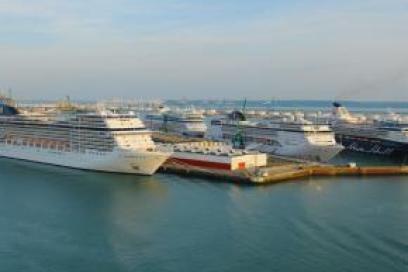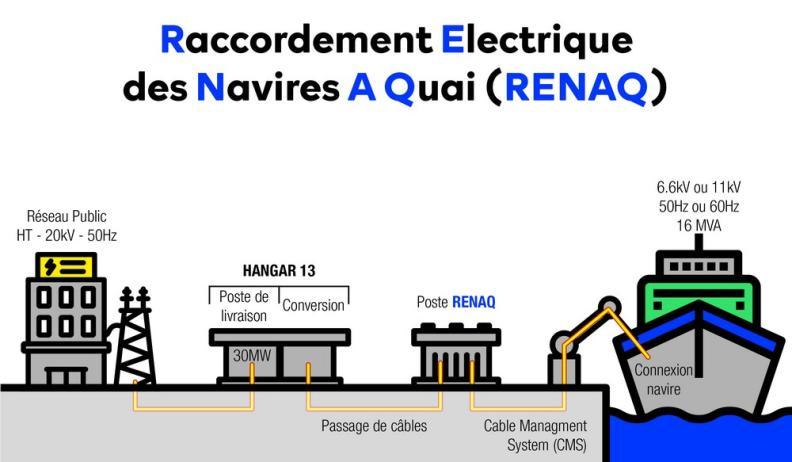- ABOUT US
- GOODS
- PASSENGERS
- MULTIMODALITY
- ECOLOGICAL TRANSITION
- INNOVATION
Electrical power supply for cruise ships at Le Havre port
HAROPA PORT has started work on achieving the goal of enabling cruise ships to connect to a landside electricity supply during their calls at Le Havre.
What is currently Hangar 13 on the Pointe de Floride will be redeveloped to house high-voltage distribution equipment along with conversion systems to adjust quayside supply to the needs of ships. A network of underground cables will be laid to take current to carriers, each weighing 15kg and providing five connection points on articulated arms for provision of supply to vessels irrespective of their location along the cruise terminal’s three quays.
Connection to the public grid, a key component of the system, entails major construction work requiring extensive collaboration: the laying of the three high-voltage cables over three kilometres and the installation of a 40MW transformer at the Source Substation. This work is being carried out under project management by Enedis – the entity responsible for managing the national electricity grid – and will be completed in 2022.
The electrification of Pierre Callet quay will be operational as early as the 2023 season and represents the first phase of what is a large-scale project. Joannès Couvert and Roger Meunier quays will offer the same vessel accommodation conditions for cruise seasons 2024 and 2025 respectively.
An investment of €20m has been earmarked for this project, which also benefits from €11.1m in support from the government’s Economic Stimulus Plan, plus a contribution of €0.9m under the Territorial Pact for Ecological and Inclusive Transition.
HAROPA PORT has ambitions and will be the first Northern European port to be able to supply 30MW to cruise ships.
Electrification of the Port 2000 quays will unfold over the period to 2028, following the protocol of agreement signed on 21 June 20211 between the five Northern Range ports: Antwerp, Hamburg, Rotterdam, Bremerhaven and HAROPA PORT.
Environmental imperatives combine with market expectations
Over and above the technical issues involved in its implementation, this project is guided first and foremost by a strong environmental desire to see reductions in greenhouse gas emissions and consumption of fossil fuels. A local impact is also expected with regard to air quality in the vicinity of the terminals given that in the short term the cruise ships connected to the quayside power supply will be cutting their emissions significantly in volume terms during their calls at the port. These ecological issues are accompanied by market expectations: using this quayside electrification programme, HAROPA PORT intends to consolidate its competitiveness on the Northern European cruise market and enhance its attractiveness for cruise operators and actors generally along the entire transport/logistics value chain.
Along the Seine Axis
Other projects are currently under development at terminals in Rouen and Paris. HAROPA PORT and VNF (French Waterways Authority), with support from the European Commission, are installing 78 riverside connection points for supply of water and electricity to freight barges and river cruise boats2, adding to the 14 connection points already installed since 2018. In Paris, the quays of Grenelle port have a system specifically intended for passenger boats calling at the port; to date, one connection point has been installed and six others will have been added by 2023.
In line with the goals announced by the European Commission for achieving the target of a minimum 55% reduction in greenhouse gas emissions by 20303 and the implementation of practical measures, HAROPA PORT is endeavouring to make an active contribution to the combat against climate change. In this global effort, one of the levers for controlling greenhouse gas emissions is the decarbonization of maritime transport.

